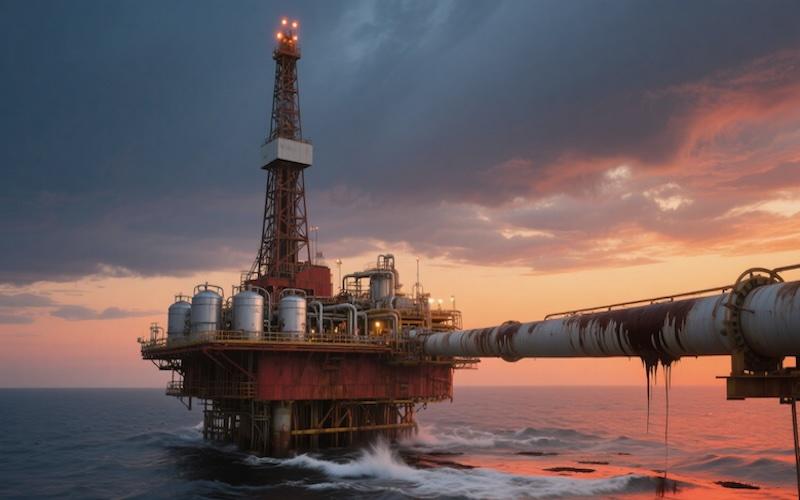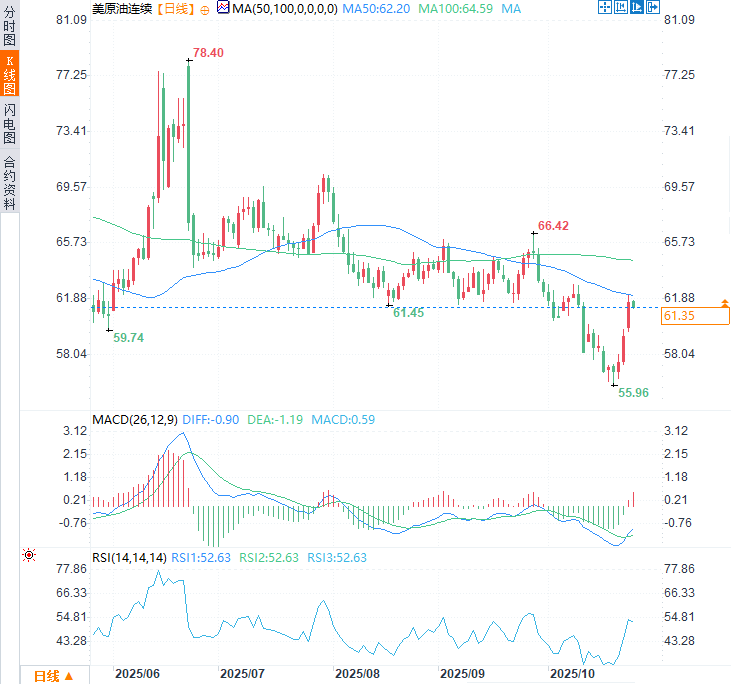Crude Oil Trading Alert: Sanctions Raise Supply Concerns, Oil Prices Rise Over 5% Before Taking a Breath
2025-10-24 10:58:50
Brent crude futures fell by about 0.63% to $65.47 a barrel on Friday, while U.S. crude futures fell by about 0.73% to $61.34 a barrel. Both benchmark crude futures surged by more than 5% on Thursday, putting them on track for a weekly gain of about 7%, the biggest gain since mid-June. U.S. crude prices reached a two-week high of $62.20 a barrel.
In addition to the surge in crude oil prices, U.S. diesel futures jumped nearly 7%, pushing diesel crack spreads, a measure of refining margins, to their highest since February 2024.

Trump imposes sanctions on Rosneft again
Russian President Vladimir Putin maintained his tough stance on Thursday after U.S. President Donald Trump imposed sanctions on Rosneft and Lukoil, which together account for more than 5% of global oil production, to pressure him to end the conflict between Russia and Ukraine.
Refiners in India, the largest buyer of Russian seaborne oil, will significantly cut crude oil imports, according to industry sources.
“The US announcement of sanctions against Rosneft and Lukoil is a significant escalation in targeting Russia’s energy sector, with enough impact to push the global oil market into deficit next year,” said David Oxley, chief climate and commodities economist at Capital Economics.
The United States said it was ready to take further action, while Putin denounced the sanctions as unfriendly actions, saying they would not have a significant impact on the Russian economy and stressed Russia's importance to the global market.
Putin also said Moscow would never yield to pressure from the United States or any other foreign power, and warned of an "overwhelming" response if targets deep inside Russia were hit militarily.
U.S. energy data shows that Russia will be the world's second-largest crude oil producer after the United States in 2024.
Saxo Bank analyst Ole Hansen said the U.S. sanctions meant major buyers of Russian oil would need to find alternative suppliers to avoid being shut out of the Western banking system.
EU adopts 19th round of sanctions against Russia
European Union countries also approved a 19th round of sanctions against Russia on Thursday, including a ban on imports of Russian liquefied natural gas, while Britain imposed sanctions on Rosneft and Lukoil last week.
The sanctions package includes a complete trading ban on Rosneft and Gazprom Neft, sanctions on an additional 117 vessels in the shadow fleet (bringing the total number of EU-banned tankers to nearly 560), and a ban on Russian liquefied natural gas from entering the EU market through long-term contracts from January 2027 and for six months through short-term contracts.
"This nineteenth round of sanctions will not be the last," EU High Representative for Foreign Affairs and Security Policy Katja Kallas said on Thursday.
Lars Lokke Rasmussen, Foreign Minister of Denmark, which currently holds the rotating EU presidency, announced: "The EU has today agreed on the nineteenth round of sanctions under the Danish presidency. This is a decisive step towards cutting off Russia's largest source of revenue - oil and gas revenues, and also introduces further measures against the shadow fleet." He added: "Combined with the new US sanctions, this will have a serious impact on the Russian economy."
The EU has been debating this round of sanctions for more than a month since it was first submitted, with Slovakia, Hungary and Austria insisting on ensuring that their energy costs would not surge after they switched away from Russian energy.
OPEC production increase expectations put pressure on oil prices
Kuwait's oil minister said OPEC is ready to increase crude oil production by further lifting production cuts if necessary to address market shortages.
"Buying due to concerns about tight supply due to U.S. sanctions on Russia has weakened," said Satoru Yoshida, a commodity analyst at Rakuten Securities.
"As long as OPEC maintains spare production capacity, a unilateral rise is unlikely," he said, predicting that the price of U.S. crude oil will continue to trade in the range of about $5 above and below $65.
Trade tensions between the world's two largest economies have been escalating, and the news that the two leaders will meet next week appears to have eased tensions.
Technical Analysis
From a technical analysis perspective, the recent price rebound has shifted the short-term outlook from bearish to neutral to bullish.
On the upside, the initial resistance of US crude oil is in the range of $61.50-61.70. If it effectively breaks through and stabilizes above this resistance range, the next resistance will be at the 50-day simple moving average (SMA, 62.20). Although this key moving average indicator temporarily suppresses the upside space, if the daily line can strongly break through this resistance level, it will confirm that the bulls have regained the initiative and pave the way for probing the next key resistance level of the 100-day moving average (64.59).
On the downside, initial support is seen near Thursday’s low of $59.65, with subsequent support at $57.00 and the May swing low of $55.30.
Momentum indicators are showing positive signals: the relative strength index (RSI) rebounded from near oversold territory to above its midline, suggesting growing bullish momentum; while the MACD, although in negative territory, is turning up, suggesting a strengthening bullish bias, though a fully established uptrend has yet to take shape.

(U.S. crude oil continuous daily chart, source: Yihuitong)
At 10:58 Beijing time, U.S. crude oil was reported at $61.38 per barrel.
- Risk Warning and Disclaimer
- The market involves risk, and trading may not be suitable for all investors. This article is for reference only and does not constitute personal investment advice, nor does it take into account certain users’ specific investment objectives, financial situation, or other needs. Any investment decisions made based on this information are at your own risk.





















